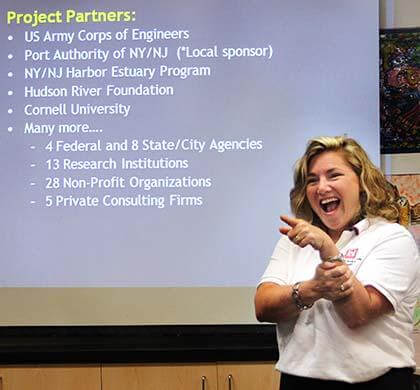By Rich Bockmann
After more than a decade of study, the U.S. Army Corps of Engineers presented its draft plan for the ecological restoration of the Hudson-Raritan Estuary to environmentalists last week at the Alley Pond Environmental Center in Little Neck.
“It’s taken a long time,” said Lisa Baron, the corps’ harbor program branch chief. “Coordinating studies and people has been the biggest challenge.”
In 1988, Congress recognized the New York-New Jersey Harbor, broadly defined as a 25-mile radius surrounding the Statue of Liberty, as a nationally important estuary — the area where the mouth of a river meets the sea. Located within one of the most urbanized regions in the country, the estuary’s ecological integrity and health has been affected by centuries of habitat loss and degradation, poor water quality, pervasive sediment contamination and lack of public access.
In 1999, the corps partnered with the Port Authority of New York & New Jersey, which provided 50 percent of the funding to conduct an ecosystem restoration feasibility study, the result of which is the draft Comprehensive Restoration Plan.
“It’s meant to be a living document,” Baron said, designed to coordinate the efforts of the environmental and community groups, government agencies and other stakeholders in the estuary’s restoration.
The plan identifies 11 ecosystem characteristics, such as islands for waterbirds and sediment contamination, and sets objectives for their restorations at 320 sites for 2015 and 2050.
“The primary goal is to create a mosaic of habitats,” said Baron.
The CRP looks to locations such as Jamaica and Little Neck bays as prime spots to build eelgrass beds, which cycle nutrients between sediments and surface waters and improve water quality.
In Flushing Bay, Powell’s Cove and Bowery Bay, the CRP suggests building oyster reefs. These reefs consist of intricately layered formations of live oysters and old oyster shells. They provide habitats and food sources for many aquatic creatures.
In October, the corps put a pilot oyster reef in the waters of Jamaica Bay.
“We wanted to contact and reach out to as many people living in the area as possible, and to spread the word,” said Baron.
The corps is looking to receive programmatic authorization from Congress by 2015, which would give it one single authority to implement the plan, as opposed to the haphazard planning it does now under multiple authorities, one project at a time.
Baron used the Florida Everglades, which received its authorization in 2000, as an example of how a unified approach would give the corps the green light to implement the restorations.
“It would say that all the projects provide value. It would be like a laundry list, where we could go down and check off projects whenever we get the funding,” she said.
Bob Servas, though, was not completely sold on the plan. Servas, an environmentalist and a boat captain familiar with the waters of Jamaica Bay, questioned the use of de-icing liquids used on the runways at John F. Kennedy International Airport which eventually end up in the bay.
“The Port Authority involvement needs to be looked at,” he said. “They’re polluting at the same time they’re planting oysters.”
Reach reporter Rich Bockmann by e-mail at rbockmann@cnglocal.com or by phone at 718-260-4574.





























